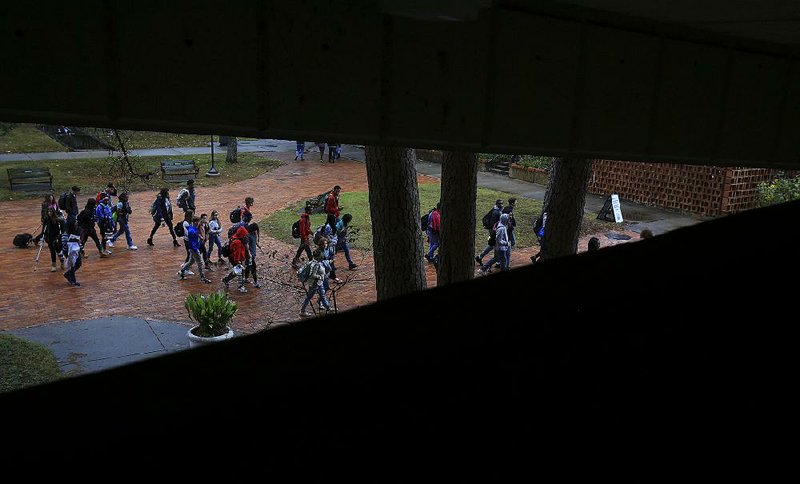Starting a football program at the University of Arkansas at Little Rock would require a significant investment of money beyond just an increase in the budget for athletics, according to a consultant's report released Tuesday.
The university "makes a concerted effort to provide an array of student services but is challenged at times to meet the needs of its approximately 11,000 students, including student-athletes, due to resource constraints," the 144-page report by Conventions, Sports & Leisure International said.
The athletic budget would have to grow from the current $11 million a year to as much as $23.4 million, depending on which level of NCAA participation the university chose, according to the report. The financial figure doesn't include the cost of new facilities that would be needed, even with the use, through a rental agreement, of War Memorial Stadium.
A marching band with auxiliary groups -- such as a drum and bugle corps -- would have startup costs of $500,000 and annual operating costs of $200,000 to $300,000.
"It's good to see the report," UALR Athletic Director Chasse Conque said. "It's been a lot of work on a campus-community collaboration."
Conque said nothing in the report was a surprise because he has been working with the consultants throughout the project.
[DOCUMENT: Read the complete UALR football feasibility study]
"The real work is now," Conque said. "What we wanted from the firm was unbiased facts, and you have to acknowledge the price tag and the investment needed."
UALR last played football in 1955, when the school was known as Little Rock Junior College. In 1949, the school claimed the national title for junior college football programs with a 9-0 record against schools primarily in Arkansas.
Talk of reviving the program has popped up periodically, most recently in 2017 when UALR students presented Chancellor Andrew Rogerson with a petition of 1,000 signatures supporting the idea.
In February, the university posted a website survey and sent email questionnaires to some 90,000 UALR students, staff, alumni, business leaders, donors and corporate sponsors to gauge support for the idea, including whether that support would extend to their pocketbooks.
Conventions, Sports & Leisure International gave projections for a football program for the next 10 years, basing scenarios "on potential revenue, potential enrollment impact, economic impact on the city of Little Rock and alumni involvement." It also made comparisons with other college athletic departments with and without football programs.
The report assumed a startup date of next June, when UALR would notify the NCAA of its intentions to implement a football program, with the first season a year or two after that.
Adding football -- along with increasing the number of female student-athletes to comply with federal law -- "essentially would double" the number of student-athletes overall at the university and would require proportionate growth in support services for all students, the report said.
"Assorted infrastructure upgrades are required -- with or without football," its authors said. "Generally, student-athlete well-being is measured by access to quality coaching, academic support, medical care, housing, dining, team travel, and facilities."
The university already is short in most of those areas and has acknowledged those shortcomings, the study said.
At least two new women's sports -- or about 30 additional female student-athletes -- would be needed to comply with Title IX, the federal anti-discrimination law that also applies to college athletics. The increase in women athletes, along with new football players, would boost the number of student-athletes at UALR from 200 to about 400, the report said.
Assuming War Memorial Stadium would be used as the site for six home games per year, UALR still would need to build new facilities for practice, football operations and support services, the report said, boosting costs to as much as $39 million, excluding land purchases.
The report said UALR's budget for athletics, with a football program, would grow to $18.8 million if the Trojans participated in the NCAA's Football Championship Subdivision (FCS) level, formerly known as Division I-AA. Its budget would grow to $23.4 million at the NCAA's highest level, the Football Bowl Subdivision (FBS), formerly known as Division I-A.
"Likewise, [f]ootball-driven revenues are expected to increase as well, but they would not fully offset anticipated expenses," the report said.
UALR is a member of the Sun Belt Conference, which is in the Football Bowl Subdivision, as is Arkansas State University. UALR and the University of Texas at Arlington are the only Sun Belt Conference schools without a football program.
Conque said his preference would be for a UALR football team to compete in the Football Bowl Subdivision.
The study's authors didn't give a final overall recommendation but said the difference between UALR's athletics budget and those of comparable schools "accentuates" the challenges in starting a football program.
The Plano, Texas, company was paid $125,000 for the study released Tuesday. The company conducted a separate, $160,000 study earlier on the future of War Memorial Stadium in Little Rock. That study was paid for by the state Department of Parks and Tourism.
UALR, using private funds in its athletic department, contributed $53,500; Little Rock paid $41,500; and the Department of Parks and Tourism paid $30,000 toward the study.
UALR's survey in February is a key part of the consultants' study.
Some 3,000 surveys were completed, with 61 percent of respondents giving a positive opinion on the current state of UALR athletics and 67 percent in support of adding football. Students, at 76 percent, made up the largest segment of football boosters, with a majority of those stating that they'd likely support an increase in activity fees to help pay for the program or at least pay for tickets.
UALR has the highest activity fees in the state, at $21 per credit hour.
The survey showed 76 percent of respondents expressed an interest in attending games and 68 percent preferred membership in the Football Bowl Subdivision.
Those numbers fell dramatically when respondents were asked about financial contributions outside of buying tickets.
"A critical component to the success of a football program is the depth and breadth of its donor base," the study's authors wrote.
Overall, 27 percent said they would be interested in making a startup contribution for a football program, with current athletics patrons showing the most interest, at 37 percent, and alumni at 29 percent. Twenty-four percent of overall donors expressed such an interest. Faculty and staff members, at 17 percent, showed the least interest.
Eleven percent of the survey's respondents said they were answering on behalf of their business or business and family. Of those respondents, 51 percent said they would be interested in becoming football sponsors.
"I won't say [they're] disappointing, but they are a challenge," Conque said. "You cannot approach this with lukewarm feelings. This will take not just the university community but our entire city."
STUDENTS, ALUMNI, DONORS
With about 11,000 students, UALR ranks ninth among the Sun Belt Conference's 11 schools, a 12 percent decrease since peak enrollment in 2010, the report said. Its total full-time undergraduate enrollment of 8,814 students is 30 percent lower than that of other schools in the Southland and Ohio Valley conferences, 64 percent lower than other schools in the Sun Belt Conference, and 68 percent lower than the average in Conference USA.
UALR's alumni base, at 57,000, also is smaller than most of those at similar-size schools in the conferences studied.
"Fundraising will be an integral component of initiating the creation of a new football program as well as in sustaining its success," the report said.
At 890 donors, UALR is second among schools in the Southland and Ohio Valley conferences in the Football Championship Subdivision "but ranks quite low among the comparable FBS conferences," the report said. The report noted that Arkansas State University has 1,400 donors.
Without football, UALR's current budget of $10.6 million for athletics is, as expected, considerably smaller than those at similar institutions, the report said. It also offers, on average, a smaller number of intercollegiate sports.
Football constitutes "a significant portion" of athletics budgets, the report said. As an example, football takes up 49 percent of ASU's $19 million athletics budget for fiscal 2017.
THE MARKET
The Little Rock metropolitan area, with a population of about 750,000, is larger than the metropolitan areas of comparable schools in the Sun Belt, Southland and Ohio Valley conferences. Only Conference USA, with schools in and around Dallas, Houston and Charlotte, N.C., is larger, according to the report.
The Little Rock area rated well in projected rate of growth, as well as in median age, median incomes and the cost of living, the consultants said.
A football program in Little Rock would compete directly with that of the University of Central Arkansas in Conway and the University of Arkansas at Pine Bluff, the report said, noting that the shadow of the University of Arkansas, Fayetteville would loom large.
Traditional statewide support for the Razorbacks would be "a unique challenge" to the startup football Trojans, the report said.
A donor base of 16,000 "underscores the influence the University of Arkansas has in terms of fandom and support," the report said, noting the UA's continued use of War Memorial Stadium for football "has the potential to bifurcate fandom, program support, and sponsorship dollars."
GROWTH
The report noted UALR's goal of increasing enrollment from 11,000 to 15,000 by 2022 and said adding football "could aid" in that goal.
It studied enrollment trends at six institutions that have started or reinstated football in the past 10 years, including the University of South Alabama, the University of North Carolina at Charlotte and the University of San Antonio. On average, those institutions saw freshman enrollment grow by nearly 15 percent, although the report cautioned that football wasn't the sole reason for increases.
A similar gain at UALR would boost enrollment to 13,500 over a couple of years, the report said, but it noted that an increase in enrollment also brings an increase in other costs and resources.
WAR MEMORIAL STADIUM
The future of state-owned War Memorial Stadium, which opened in 1948, has been in question for several years with fewer Razorback games played in the stadium. The Razorbacks have played at least one game a year at the stadium since its opening.
University officials announced in May that the Razorbacks will play a regular-season game against the University of Missouri every other year starting in 2019, and will play host to the Red-White spring intrasquad game in the other years.
The $160,000 study of the stadium by Conventions, Sports & Leisure International, released in March showed about $17 million worth of maintenance and improvements were needed at the stadium. It specifically cited 34 improvements, with "critical changes" needed within three years and "noncritical" ones within five years.
Direct management of the stadium was transferred to the Department of Parks and Tourism in 2017. The stadium's eight-member commission will continue to be appointed by the governor, with its decisions subject to approval of the parks and tourism director.
Little Rock Mayor Mark Stodola said he was pleased with the overall report and noted its challenges as well, especially in raising money for the larger, capital expenses for new facilities and services.
"I think the increases in operations expenses aren't insurmountable," he said. "I'm encouraged by it."
Stodola said he was impressed by the level of support expressed through the surveys.
"My idea about football is about the long-term growth of the university, for it to be a true four-year school with the complete college experience," he said. "Football is not an end-all be-all, but there are a lot of collaterals to it, to increase value to the city."
A Section on 07/25/2018



